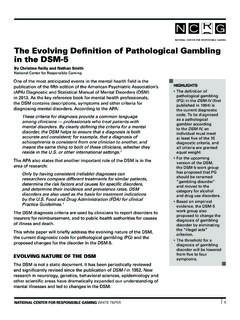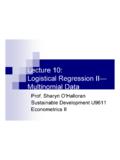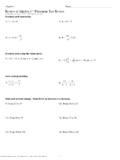Transcription of VOLUME 5 Evaluation Self-Exclusion as an Intervention for ...
1 INCREASING THE ODDSA Series Dedicated to Understanding gambling DisordersEvaluation self -Exclusionas an Intervention forDisordered GamblingVOLUM E 5 2010 National Center for Responsible Gaming. All rights reserved. Parts of this publication may be quotedas long as the author(s) and NCRG are duly recognized. No part of this publication may be reproduced ortransmitted for commercial purposes without prior permission from the NCRG. TABLE OF CONTENTS INCREASING THE odds VOLUME 5 Evaluating self -ExclusionINTRODUCTION1 Self-Exclusion as a Growing Trend in Intervention Programs for disordered Gamblingby Glenn Christenson, NCRG ChairmanCOMMENTARY3 The Emergence of Self-Exclusion Programsby Kevin Mullally, General Counsel and Director of Government Relations,Gaming Laboratories InternationalRESEARCH SUMMARIES7 What Motivates Gamblers to Seek Help and Change Their Behavior?
2 By Helen Suurvali, summary of Suurvali, H., Hodgins, , & Cunningham, (2010). Motivatorsfor resolving or seeking help for gambling problems: A review of the empiricalliterature. Journal of gambling Studies, 26, Self-Exclusion Programs Can Inform Public Health Strategiesby Richard A. LaBrie, summary of LaBrie, , Nelson, , LaPlante, , Peller, , Caro, G., &Shaffer, (2007). Missouri casino self -excluders: Distribution across time andspace. Journal of gambling Studies, 23, the Missouri Voluntary exclusion Programby Sarah E. Nelson, summary of Nelson, , Kleschinsky, , LaBrie, , Kaplan, S., & Shaffer, (2010). One decade of self exclusion : Missouri casino self -excluders four toten years after enrollment.
3 Journal of gambling Studies, 26(1), Benefits to Gamblers through self -Exclusionby Robert Ladouceur, summary of Ladouceur, R., Sylvain, C., & Gosselin, P. (2007). self -ExclusionProgram: A Longitudinal Evaluation Study. Journal of gambling Studies, 23, Improvements in a Self-Exclusion Programby Robert Ladouceur, summary of Tremblay, N., Boutin, C., & Ladouceur, R. (2008). Improved Self-Exclusion program: Preliminary results. Journal of gambling Studies, 24, Programs in the United States and International Casino JurisdictionsADDITIONAL INFORMATION49 Resources and Programs52 About the National Center for Responsible Gaming53 About the Institute for Research on gambling DisordersThe first four volumes of Increasing the Oddsare available via the NCRG s website, INTRODUCTIONSelf- exclusion as a Growing Trend in Intervention Programs for disordered Gamblingby Glenn ChristensonChairman, National Center for Responsible GamingThis VOLUME of Increasing the odds : A Series Dedicated to Understanding GamblingDisordersfeatures the latest research on Self-Exclusion , a growing trend in interventionprograms for disordered gambling .
4 While specific program components vary, Self-Exclusion programs now offered by many casinos and governments in the United Statesand around the world allow individuals to voluntarily ban themselves from enteringcasinos for a specified time period that can range from months to a lifetime. Casinos, inturn, are responsible for enforcing the voluntary ban. Despite the increase in theseprograms, particularly during the last 10 years, Self-Exclusion is still a relatively new focusin research on responsible gaming and disordered gambling . Fortunately, the pool ofresearch published in peer-reviewed journals is growing, and the NCRG is pleased to bringthis research beyond the scientific arena and to the public. The studies included in this issue examine a number of critical areas, from thecharacteristics of self -excluders and what motivates them to action to the effectiveness ofthe voluntary Self-Exclusion programs.
5 The findings presented here can be used to shapethe development and implementation of new and existing programs, leading to moreeffective results for individuals who want to stop or reduce their gambling activities. Kevin Mullally, author of the first state Self-Exclusion program implemented in the UnitedStates in 1996 by the Missouri Gaming Commission, provides a historical perspective in The Emergence of Self-Exclusion Programs. Mullally not only outlines the evolution ofself- exclusion and, specifically, Missouri s seminal program, but highlights some of thechallenges presented by the lack of research on the subject at that time. Since then, Self-Exclusion programs have proliferated in the United States and internationally.
6 TheAppendix, Self-Exclusion Programs in the United States and International CasinoJurisdictions, summarizes current programs, including their locations, terms ofenrollment, and, if applicable, accompanying treatment support in a Self-Exclusion program is a form of help-seeking behavior, akin to attendinga Gamblers Anonymous meeting or entering talk therapy. Because most people strugglingwith addiction, including those with disordered gambling , do not seek external help, it isvital for scientists, health care providers and policymakers to understand what motivatesthe people who do seek assistance. Helen Suurvali summarizes a literature review of 19empirical studies on what factors prompt individuals to address gambling behaviors in What Motivates Gamblers to Seek Help and Change Their Behavior?
7 This study exploredthe various reasons that led people to stop or reduce their behavior on their own, seekoutside help or enroll in Self-Exclusion programs. As one of the oldest Self-Exclusion programs, the Missouri Voluntary exclusion Program(MVEP) has yielded extensive data available for researchers. The Division on Addictions atCambridge Health Alliance conducted a study of the MVEP in two phases. In How Self-Exclusion Programs Can Inform Public Health Strategies, Richard LaBrie reviews phase1 INCREASING THE odds VOLUME 5 Evaluating self -Exclusionone of the study that analyzed whether the number of people enrolled in a self -exclusionprogram is a predictor of the concentration of disordered gambling . The findingsdemonstrate that the number of people enrolling in Self-Exclusion programs can provide acost-effective measure of the disordered gambling prevalence rate in a given area, andinform how public health officials allocate prevention and treatment resources.
8 Research on interventions raises questions about the effectiveness of the strategy. Doesself- exclusion offer a safe and accessible means of help for individuals concerned abouttheir gambling ? In Evaluating the Missouri Voluntary exclusion Program, Sarah Nelsonreviews the findings of phase two of the MVEP study that showed positive outcomes forthe self -excluders but also suggested that the act of enrolling in the program rather thanits enforcement appeared to be the key factor in the reduction of problematic casino in Montreal, Quebec, has also given researchers the opportunity to study Self-Exclusion . Robert Ladouceur summarizes the findings of a two-year study in EarlyBenefits to Gamblers Through Self-Exclusion .
9 He found that self -excluders experienceda positive impact from the program in the early stage of enrollment. Ladouceur andcolleagues followed up this research with a later study of program improvementsinstituted by the Quebec casino, including the additions of counseling and telephonesupport. He recaps this research in Testing Improvements in a Self-Exclusion Program. The study found a number of positive outcomes for the self -excluders, suggesting theimportance of additional service components, such as contact with a designated counselorand access to outside help resources. The research presented in this VOLUME raises a number of important questions that shouldbe considered by policymakers who mandate Self-Exclusion , by gambling regulators whoshape the programs, by gaming operators who implement the programs, and by themental health care community concerned with the individuals enrolled in self -exclusionprograms.
10 The NCRG hopes that translating this research for the public will assist all ofthese stakeholders in their common goal of preventing gambling -related harms. 2 INCREASING THE odds VOLUME 5 Evaluating Self-Exclusion > Self-Exclusion as a Growing Trend in Intervention Programs for disordered gambling 3 INCREASING THE odds VOLUME 5 Evaluating self -ExclusionCOMMENTARYThe Emergence of Self-Exclusion Programsby Kevin MullallyGeneral Counsel and Director of Government Relations, Gaming Laboratories InternationalIn roughly 20 years, Self-Exclusion programs have grown to be one of the most widelyutilized regulatory programs to address gambling disorders, both in the United States andaround the world. With a long but poorly documented history, no one can pinpoint exactlywhen programs designed to allow gamblers to voluntarily exclude themselves fromgambling opportunities emerged.








